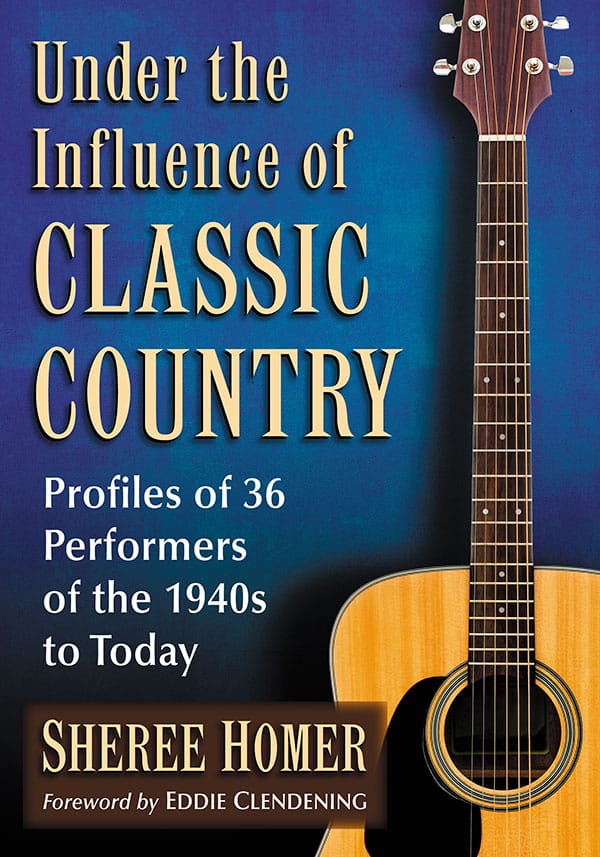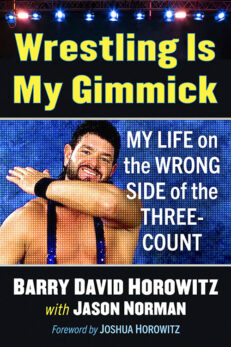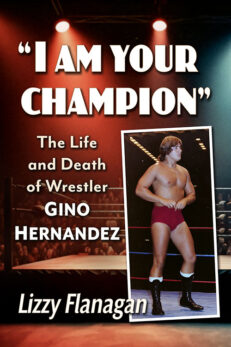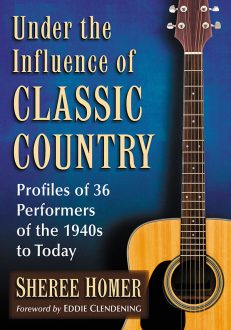Rockabilly ‘n’ Blues interviews Sheree Homer about her book Under the Influence of Classic Country.
It’s always great to find like-minded individuals that share a common interest in preserving the legacy of roots music and helping introduce new acts along the way as well. Sheree Homer continues to be one of those people and I asked her some questions concerning her new release on McFarland titled, Under the Influence of Classic Country. Find more information at McFarlandBooks.com and let them know how much you love what Sheree is doing by buying copies for family and friends this Christmas!
Lets hear from Sheree Homer about this fantastic new book.
-How did the idea of this book come about? How long did it take to compile?
I originally wanted to write a book about rhythm and blues artists, but the interviews weren’t coming together like I had hoped, so I switched gears. I emailed my publisher with the idea of doing a classic country book. They accepted it, and then I set out to find people to interview. Since I have been on the roots music scene for years, I was used to calling an artist directly and asking for an interview, but with Under the Influence of Classic Country, I had to sell myself to PR (Public Relations) and management teams. That was a bit of a challenge because you never know if you’ll hear back. I sent out hundreds of queries, but only heard from a select few. I am happy with the ones that answered though. It took me two and a half years to do the research and write the text. It always takes me a long time because I am a procrastinator and a perfectionist, a bad combo- ha.
-You’re a fan of classic country but you mentioned you weren’t when you were younger. Was there a song or artist that changed that for you?
That’s a very good question. I remember when I first got into rockabilly, but to be honest not sure when or how it happened that I became a fan of country. I am assuming it’s from hearing Waylon Jennings. Lately, SiriusXM Radio, in particular, Willie’s Roadhouse, has introduced me to songs and artists that I had not heard before. That’s always fun for me, to hear “new” music.
-The more history I dig into rockabilly, the more I find it’s tied to country and other roots. Do you think this history may get lost in the story of modern rockabilly sometimes?
Rockabilly is definitely connected to country, rhythm and blues, and even gospel. I think of music as a tree with branches and roots. It’s all intertwined. I don’t think that the history gets lost in modern rockabilly because so many of the younger artists were influenced by country greats. For example, Kim Lenz was inspired by Faron Young, and Marti Brom counts Patsy Cline as one of her influences. Plus, acts like The Cactus Blossoms are keeping the harmonies of The Everly Brothers and The Delmore Brothers alive and well with their recordings. Whether it’s a legendary act or a newer artist on the scene, I always ask who their influences are. I find that very interesting, to hear how their sound was created.
-I saw that tour with Willie Nelson and John Fogerty. I went for John but also walked away a big fan of Willie. I wasn’t raised on classic country but I’ve certainly became a fan. Seeing him on that tour made me “get it” when it came to him.
I, too, became a fan of Willie’s after seeing him live. Loved his rockin’ band too, which included his sister on boogie woogie piano. I was pleasantly surprised. I wish I could have met him and kick myself for blowing the chance since I had a backstage pass. I appreciate that he’s always been nice to his fans. I admire that he has remained humble. I also love the songs he has written for others, such as “Hello Walls” and “Crazy.”
-Eddie Clendening wrote the forward and is a great artist himself. I’m so happy to see him nominated for Rockabilly Male for the 2020 Ameripolitan Music Awards.
Eddie is a dear friend, and I’m so happy he provided my foreword. It’s great that he’s finally getting some overdue recognition. Here’s hoping he wins Best Rockabilly Male. He certainly deserves it.
-Does it feel like a new generation is discovering these roots…classic artists and new artists with a similar feel? To me, it feels like we’re in a cycle where people are looking back and appreciating our heritage acts. Even though some artists were overlooked in the Country Music documentary, I’m happy to see a resurgence in attention for these artists.
I think with any genre, rockabilly and swing included, there are always periods of renewed interest. My publisher chose the perfect moment to release my book, right around the same time as Ken Burns’ documentary. I didn’t know they were going to do that, but I’m thankful they did. The documentary peaked curiosity for those who may not be familiar with country, but I also think Dolly Parton’s newest projects will help. She has a podcast and also a series on Netflix, which I am anxious to watch. I enjoyed the Lifetime movie, Patsy and Loretta, too. I thought it was very well done, and I actually wanted to see more. I am thrilled that the legends, especially, are getting more respect and recognition before they pass away. Now is the time to tell them how much they are loved and revered. Words and accolades don’t mean a thing once they are no longer here to enjoy the praise.
-I feel like your book is great timing because of this cultural shift to looking at our heritage acts. You do a fantastic job of looking at the past and shining a spotlight on these developing acts. Were there some artists that you discovered while researching?
To be honest, I wasn’t that familiar with the history of country music before writing my book and watching the documentary. I learned a lot. There were several artists I discovered, such as Connie Smith and Sarah Gayle Meech.
-I know it’s hard to pinpoint some of your favorite stories in here but do you have a couple that you’d like to share?
Sure, my favorite involves Ernest Tubb. I spoke with his longtime steel guitar player, Lynn Owsley, so he related this story to me. One night, they got bored and decided to start a game of Craps. Owsley, Tubb, and some other members of The Texas Troubadours played long into the night. Owsley was winning all the pots and was even borrowing some of the money back, so the game could continue. Finally, it was just between him and Tubb, and Owsley decided to call it a night. He said he was tired, but Tubb wouldn’t let him leave. He had to win back some of his money. Owsley told him, “I’m not giving you any more unsecured loans.” Tubb then offered his initial ring and guitar, but Owsley wasn’t interested. Tubb then said, “Well, what do you want?” Owsley replied, “Your bus.” Owsley won, and he was the legitimate owner of “The Green Hornet” bus for two weeks before Tubb could acquire enough money to buy it back. Incidentally, the day after the game, Owsley moved many of Tubb’s belongings from his stateroom at the back of the bus into his bunk and his possessions into Tubb’s room. Without paying attention to the alteration, Tubb walked into his old room unannounced, to find Owsley spread out on his bed. To which, Owsley told him, “It’s not polite to enter a man’s bedroom without knocking.” Thankfully, they were good friends, so it was all in jest.
Most people may not know that Loretta Lynn doesn’t own the copyright to some of her best known songs, including “Coal Miner’s Daughter,” “Fist City,” “You’re Lookin’ at Country,” and “You Ain’t Woman Enough”- 114 in total. In the early 1960s, when she first arrived in Nashville, Doyle and Teddy Wilburn took her under their wing and had her sign both a lifetime managerial and songwriting contract. She was anxious to be a big star, so she didn’t think twice about the meaning of those contracts. By 1971, she saw everyone around her getting rich, but she wasn’t. She asked to be let out of her contracts, and when they refused, she took them to court. They counter sued for five million dollars. Lynn won, didn’t have to pay the money, and she was released from the managerial contract because the judge said The Wilburns weren’t looking out for her best interest. Unfortunately, they were allowed to retain copyright on her songs and do so to this day.
In September 1967, while fishing on the Cumberland River, Jerry Reed received a phone call from producer Felton Jarvis requesting that he come down to RCA Studio B immediately. Elvis was trying to cut his “Guitar Man” to no avail. None of the session guitarists could duplicate Reed’s sound. Presley and Reed became instant friends, and they fed off of each other’s energy. Presley’s version turned out exactly like he had hoped with Reed in the studio. Once it was cut though, that was a different story. If your song was recorded by Presley, you had to give up 50% of your royalties. When Reed was told this, he refused. In fact, he reminded Freddy Bienstock that none of them needed the money, so “why don’t we just forget we ever recorded this damn song?” However, Presley stood up for Reed and told him he could keep his songwriting credit. It was the first and only time that that ever happened. It wasn’t released as a single though, but rather as an album track and also used throughout the ’68 Comeback Special. The latter made a lot of money for Reed, and he was very grateful.
-I’m so glad you included Jerry Reed in here. I’ve been trying to listen to more of him and the Elvis stories in particular are golden. Were you a fan of the Elvis covers before you started listening to Jerry?
Before the book, I had never heard Jerry’s version of “Guitar Man.” I was most familiar with his novelty tunes like “Amos Moses” and “When You’re Hot, You’re Hot.” Elvis is my favorite singer, so of course I had heard his version of “Guitar Man” many times over the years. Plus, it’s “an anthem” throughout his Comeback Special, which I love. It was fascinating to hear that Jerry wanted to be taken seriously as a singer, songwriter, and guitarist. He got tired of being strictly known for his novelty songs, in the realm of Ray Stevens.
-It’s so important to keep these names alive and I know for me, your book made me want to listen to more Charley Pride, Ernest Tubb, Lefty Frizzell, Jeannie Seely but also newer acts like Carmen Lee, Randy Rich and others. This has to be a good feeling to know folks are responding in this way…you’re either telling them about an artist for the first time or giving a good reminder that they need to have a refresher course.
To hear that pleases me more than I can say. Thank you James! That’s definitely one of the reasons for including newer acts, to introduce them to an audience that they may not be familiar with. I feel like I have achieved my purpose with the book when someone tells me they have discovered a new artist and perhaps have become his/her fan. I also appreciate when a reader decides to dig a little deeper into a legendary act’s catalog. I really try hard to preserve musical history. It’s so important for me to tell their stories. I have often told an artist to write down their history. Even if it never gets published, at least it is there for his/her family. Once they die, their stories die with them. Unfortunately, I have heard artists tell me they were going to write his/her own book, and it never happens. Dale Hawkins and Billy Lee Riley come to mind instantly in that regard.
-Your books are quickly becoming the definitive source for many artists. Ricky Nelson is one of those for sure. What’s next for you and are there some “dream” interview artists that you’d still like to sit down with?
I am currently working on a tribute artist book. There will be forty acts profiled in that one. Many of them will be ETAs (Elvis Tribute Artists) but also those who pay homage to Jerry Lee Lewis, Johnny Cash, James Brown, Patsy Cline, etc. I have a bucket list of interviewees. A few of them include Dion, Brenda Lee, Willie Nelson, Dolly Parton, Connie Smith, Marty Stuart, Darlene Love, and Loretta Lynn.





